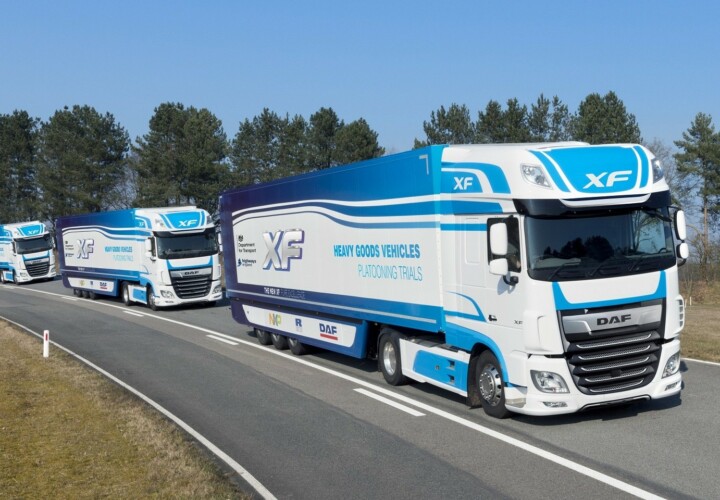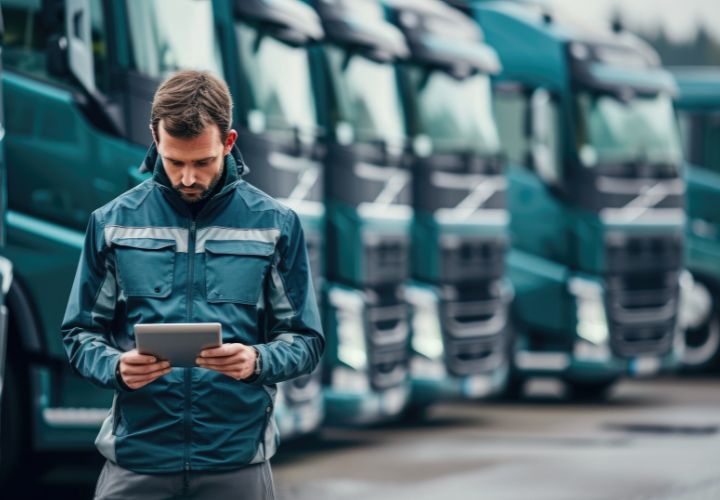Whether it’s driving efficiency improvements in today’s logistics operations or providing the backbone for a new generation of self-driving trucks, real-time connectivity has become as essential as the fuel in the truck.
The race to be a global leader in autonomous, self-driving and connected vehicles is well and truly on. Technology companies, vehicle manufacturers and governments are all joining in, with huge investments being made in the development of infrastructure as well as advanced automotive technologies.
There’s even an acronym for this new breed of vehicles – CAVs (Connected and Autonomous Vehicles).
All this activity might suggest that self-driving vehicles and truck platoons are just around the corner, but there remain some important milestones yet to overcome – pubic acceptance, liability in the event of an accident and the ability to roll-out the technology from relatively small-scale development projects to widely-available services, to name a few.
Self-driving cars, pods and trucks are, however, beginning to migrate from the proving ground to road trials.
Truck Platooning
Many hauliers remain to be convinced about the benefits of truck platooning, but for governments struggling to make roads safer, improve air quality and reduce congestion, they are an attractive proposition.
Platoons make better use of road space, increase safety by reducing the time it takes to react to events on the road and reduce emissions, thanks to the slip-stream benefits for the trucks in the platoon. Platooning vehicles do not overtake each other, leading to claims that overall traffic flows would be improved. Truck platoons may also prove more publicly acceptable because there is always a driver in each truck.
The most obvious candidates for convoys are long-haul, container traffic to-and-from ports and multiple trunking operations to and from the same location, or high-volume trunking which require several vehicles on the same route at the same time.
Platoons are also seen as contenders for greater load sharing or delivery consolidation– loads will be consolidated for trunking operations, then transferred to smaller city-friendly electric vehicles for final deliveries, for example.
Regardless of whether the technology proves capable of eliminating the need for a driver, it’s likely that a driver in each vehicle may be necessary for platooning to work in a commercial environment, so that individual trucks can join and leave a platoon at different sections of a journey.
Connectivity
Many of the on-board systems required for self-driving trucks have been proven and, indeed, are available on today’s production trucks. However, the more complex connectivity technology remains to be proven in real-life situations.
Standards covering communication bandwidths and security are being developed covering Vehicle-to-Vehicle (V2V), Vehicle-to-Infrastructure (V2I) such as smart motorways, and Vehicle-to-Everything (V2X) for traffic monitoring, for example.
The more complex challenges include developing the algorithms that can “teach” vehicles how to react to dynamic road situations. Autonomous trials are moving from the proving ground to the highway as governments commit to various targets – the UK government, for example, is committed to having self-driving cars on UK roads by 2021 and to trialing the feasibility of truck platoons on UK roads.
Automation Standards
Developers are increasingly talking about Level 2, 3 and Level 4 automation. This is a reference to the US’s Society of Automotive Engineers (SAE) standards J3016 (for vehicle technology) and J3018 (for on-road testing).
Level 0: No automation. Human is in complete control.
Level 1: Some automated functions. E.g. Driver Assistance Aids including EBS braking, stability, cruise control.
Level 2: Partial automation. At least two vehicle functions work together automatically with no driver input. E.g. Adaptive Cruise Control, Lane Departure Warning, Dynamic Steering, Emergency Brake Assist, Collision Warning.
Level 3: Conditional automation. The vehicle is in control, but the human is on standby to take over if necessary. The vehicle can ask the driver for input.
Level 4: High automation. The vehicle is able to take complete total control of all functions with driver interface controls optional.
Level 5: High automation. The vehicle is in control in all dynamic conditions.
The UK Government is investing £8.1m in on-road trials of truck platooning in a consortium led by TRL, the UK’s Transport Research Laboratory, and including DAF Trucks, logistics company DHL and technology company Ricardo.
The aim is to gather objective evidence on the economic case for platooning, including safety, the commercial viability in a real-world environment, any potential impact on the UK’s strategic road network, and the acceptability of platooning for the public.
A programme of simulation, driver training and vehicle test track trials will be followed in 2020 by on-road trials that form part of regular DHL logistics operations. It is claimed to be the only trial where platooning is being trialled in real-life traffic conditions.
Autonomous Vehicle Trials
United Kingdom
CITE
CITE (Connected Intelligent Transport Environment) is a £7.1m Government-funded project trialling connected vehicle technology, infrastructure and services in real-life conditions on 40 miles of roads within Coventry and Warwickshire in order to gather intelligence on how technologies might influence journeys.
MIRA is leading the simulation and modelling activities for the project. Siemens is installing 35 ESCoS roadside units on the M40 and M42 motorways to facilitate real-time data exchange between vehicles and traffic control equipment.
What the eye sees…
As part of the Government-backed Autodrive project , Jaguar Land Rover (JLR) engineers are using dedicated autonomous test vehicles – dubbed Eye Pods – fitted with sophisticated vision systems to gather data to assess how much information future self-driving vehicles should share with other road users (but particularly pedestrians) to generate enough mutual trust.
The Eye Pods run on a fabricated city street scene, constantly analysing pedestrians’ behaviour as they wait to cross the road. The Pod spots pedestrians – and appearing to “look” directly at them, signals via green or red lights that it has identified the pedestrian and simultaneously indicates if it will stop at a pedestrian crossing or take avoiding action as necessary.
SWARM
The £1.99m SWARM (Self-organising Wide area Autonomous vehicle Real time Marshalling) project is developing a machine based, vehicle supervision system that increases the safety and integrity of a fleet of autonomous vehicles. The technology is being applied to a fleet of autonomous PODs operating in Milton Keynes.
Robotpilot
Robopilot is a trial involving electric vehicle company Arrival and parcels company UPS which aims to develop the verification and validation of the autonomous decision-making algorithms. Ultimately the aim is to have zero occupancy vehicle movements within driverless parking/manoeuvring in UPS depots, and SAE Level 4 autonomy for 10 miles driving in mixed road conditions in Gloucestershire. Phase 3, starting next year, will demonstrate auto-parking and AEBS functionality.
Last mile deliveries
A group led by IBEX Automation has received £225,000 to develop autonomous last-mile electric delivery vehicles in pedestrianised streets and shopping centres, connecting to HGV interchange areas around the edges of high streets. The vehicles can be summoned to stop at shops and at parked HGVs by the retailers, to load and unload standard-sized boxes of goods and refuse.
Europe
In Europe, a consortium called ENSEMBLE has been set up to establish agreed criteria for technology, infrastructure and regulatory requirements across national borders with on-road testing of multi-brand platoons on test tracks and international highways planned for 2021. The project recognises that viability depends on more than just the technology on the vehicles, but about how the trucks can be brought together to form a platoon.
All six European truck manufacturers involved, along with suppliers NXP, ZF, Bosch, Continental, Brembo and WABCO. It’s being led by Dutch research company TNO, who are also involved in the UK trials.
“The trucks must all be travelling in the same direction, but details of their loads must also be available because it is most effective if the truck with the heaviest load drives in front,” explains Robbert Janssen, project manager at TNO. “It is also important for the trucks’ engine power and vehicle level to broadly match, as they have to be able to brake and accelerate at about the same rate.”
The project will evaluate load matching methods.
United States
In the USA, there is less focus on truck platooning and more on solutions that embrace self-driving vehicles for the long-haul section of journeys. Less congested highways mean there are fewer safety and technical issues, and self-driving trucks help resolve the growing shortage of long-distance truckers.
Companies such as Google and Uber, already experienced in bringing disruptive technologies to market, are getting involved in self-driving cars and trucks. Google’s Waymo division and Uber Technologies’ Advanced Technologies Group are busy in this space.
One of the challenges is to teach the software about the extra complexities involved in driving large trucks compared with cars – braking distance, turning and blind spots, for example.
Uber
Uber’s autonomous trucks are reported to have been transporting cargo for commercial freight customers across Arizona’s highways. Freight is brought to cargo terminals in conventional trucks, transferred to the self-driving trucks for the on-highway transit section, and transferred back to conventional trucks for final delivery.
The latest images reveal a roof-mounted spinning 64-channel LIDAR laser sensor on the roof to improve data collection. The sensors capture much denser data on vehicle surroundings, which in turn help the software make better decisions.
Starksy Robotics
San Francisco-based Starsky Robotics claims it has already driven a truck for 7 miles in Hendry County, Florida without a human in the cab. The Starsky truck has a two-part system: remote-control to navigate trucks around truck yards and local streets for pick up and drop off, and for getting to the highway, at which point a fully autonomous system takes control.
Tesla Semi
The Tesla Semi autonomous truck is expected to start production in 2019. Two of the pre-production tractors are reported to be delivering batteries from Nevada to the Tesla factory in California.
Volvo Trucks North America has been working with FedEx and the North Carolina authorities to expand operations using its Cooperative Adaptive Cruise Control technology – a V2V communication technology based on Dedicated Short-Range Communication (DSRC).
Microlise Transport Conference
Europe’s largest road transport conference is next taking place on the 15th May, 2019. Speakers from the likes Google Cloud, Government Office for Science and MAN Truck & Bus GmbH will deliver presentations that focus specifically on the future of the industry.
It’s free to attend, and you can register at www.microliseconference.com. Join 1,200 delegates and enjoy the premier conference in road transport!




